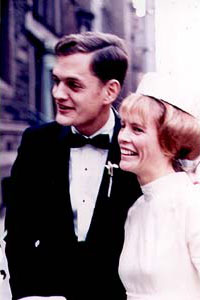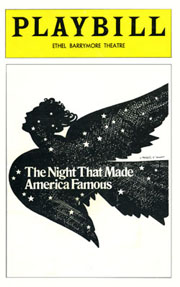Inside the
Summer Issue:
Writers Wanted:
Join Circle!
High School Principal
Follows Through On
Harry's Challenge
Better Place To Be
Is Scientist's Goal
Readers Help Shape
Circle! Through
Survey Feedback
Fan Fare
John McMenamin
Insider's Guide To
The Chapin Family
Weekend At Ovens Park
One Woman's
Simple Question
Yields A Harvest
of Food For The Hungry
Behind The Song:
What Made
America Famous?
What Made
America Famous?
Made Radio Program
Director Infamous
Choosing to Matter
Clipping Coupons
for Charities
DJ's Community
Activism Remembered
New Stage Production
Offers Harry Memorabilia
to Benefit WHY
WHY Visits
the Today Show
Click to read
the Winter 2004 Issue
Click to read
the Fall 2003 Issue
Behind the Song:
What Made America Famous?
by Linda McCarty
Picture a town a mere nine blocks long by four blocks wide, served by a barber, a grocer, a pharmacy and a couple of restaurants and bars. "It was a smaller than small town located on the south shore of Long Island, New York," said Sandy Chapin.
 |
That modest, beachfront community was the place where Sandy took her children Jaime, Jono and Jason when she left her first husband. It was the place where she and Harry later began their life as a family, and the one that became the backdrop for an event that inspired one of Harry's best-loved songs.
In need of some respite for herself and a safe, quiet and healthy place for her children, the summer rental two blocks from the ocean was perfect. The beach and a playground were ideal places for the young family to relax and play. It was simple, inexpensive, and safe.
At summer's end Sandy asked the realtor if she could lease the house through the winter and continued the rent at $90 per month. When the owners returned, she bought a place of her own.
The tiny two-bedroom home was so small "...you could paint the house standing on a chair," Sandy said, adding that when Harry put his foot on a stair it would shake the house.
Sandy was trying to get a graduate degree at Columbia University. To support her family, she took a job as secretary to the minister of the Community Church, which was comprised of the 60 or so families who did not belong to the major church of the predominantly Irish Catholic community. She not only did the office work but also wrote some Sunday sermons and taught in the Sunday School.
From outsider "summer people" status to year-round resident, she was still a "minority" resident of the town. "We proved to be outsiders in another way," said Sandy. When Harry and Sandy put a sign in their tiny patch of a front yard saying "This Family Supports Lowenstein" in support of Allard Lowenstein's candidacy, some neighbors collected signatures on a petition to remove it, saying it defaced public property. The family across the street in good humored banter countered with a sign of their own: "This Family Prefers Lowenbrau."
While Sandy's perspective on the town came mostly from talking to other mothers at the playground, "Harry played basketball and knew all the guy stuff." That included hearing about the movies that were shown at night at the firehouse, which Harry used to illustrate the town's unseen activities in his song.
After pick-up basketball games, there wasn't much to do in the town. The community was isolated at the end of a peninsula. The families were well-ordered and strict, but the kids had to make up their own fun, she said. There was a lot of mischief and some vandalism of summer homes.
Harry got the idea to give the kids a place to gather and suggested having a Friday night coffeehouse in an old brick, abandoned firehouse. "We met with the church leaders, parents and merchants in town, and it was decided that the coffeehouse would have music and activities and be chaperoned by parents who would take turns each week," she said. "It became a problem because the kids couldn't be seen before, but now they were all together with their beer cans and cigarettes."
The chaperone list got shorter and shorter. It was hard to keep the coffeehouse going and it eventually closed, she explained. "The funny thing is that there was a rumor going around that Harry was bringing booze and drugs into town."
This community was in every way "small-town America," she said. There are good neighbors in any town, and that's the essence of "What Made America Famous?"
 |
| Playbill® from "The Night That Made America Famous," the Broadway show Harry wrote and directed that featured the song "What Made America Famous?" |
"Any one of the volunteer firefighters could have responded to the alarm the night of the fire," she noted. "Harry made the plumber the hero of the story because after Jenny was born, Harry divided the upstairs bedroom to separate Jaime and the boys and was building an extra bathroom. He got to know the plumber better."
In the late 1960s when the Chapins lived there, the local realtors had an unwritten agreement that they would never rent to African-Americans. "They were trying to avoid what they imagined: 10 people to a room and bottles all over the sidewalk," she said. Then, the owner of the business block rented the apartments to African-American families, she added. Soon, there were meetings about condemning the building.
"I learned more about poverty in that one year," Sandy said. "My kids went out to stand on the corner for the school bus. The black kids were on one side of the street and the white kids on the other side. So I asked Jaime to go stand with the black kids."
"I got to know a couple of the families, and there were single mothers in the group. There was no laundromat in town, and they didn't have a car to get to one. So they took the kids' cords to the dry cleaner. It looked like poor money management, but they didn't have washing machines," she said. They were mostly single mothers who thought this would be a better, safer place for their children, she added.
Sandy remembered that her two sons befriended one boy whose mother was concerned about his whereabouts and wanted to meet and get to know Sandy. "She went to work and was very together and on top of things," she said. When Sandy realized that her sons weren't playing with the boy anymore, she asked what happened to him and went to check on the mother. "It was the kind of thing where she didn't want her boy to come to my house because she felt she couldn't have my boys at her house." She saw that the mother was not going to work and was sleeping all day. There was a drastic change in the picture of the family. "There's a lot more depression than we know about," Sandy said.
The fire happened in December, a few months after the Chapins had moved to Huntington, but they heard about it from a distance. Was it an accident or deliberately set? "When there's been such an effort to condemn the building and get people out, it makes you wonder," Sandy said.
Watch for the Next Issue of Circle! on September 7
